|
Latitude
00-53.70S
Longitude 089-36.70W
June
12, 2001
Galapagos part II - San Cristobal, Floreana & Isabela
Wreck Bay, San Cristobal
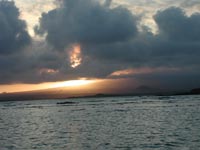 Before
we left San Cristobal, we finally managed to fit in a land tour
as well as a visit to the Darwin Interpretation Center. The land
tour got organized thanks again to Peace Corps Amy, who had yet
another friend with a taxi. The taxis in Galapagos are 2 or 4-seater
pick-up trucks with a bench or two across the back. Very practical,
actually. We got a group put together consisting of Baker and Cindy
of Lite N Up and their friend Popon, visiting from Bahia, Amy, Tregwer
and Mary Louise of the Swedish boat Onyx, plus the 2Cs, and we actually
got a beautiful day for it. Good thing, for as we left sea level
and climbed into the highlands, the temperature dropped quickly.
We just can't get it through our thick brains that it's not hot
here! The first stop was El Junco. El Junco is one of the older
volcanoes of the Galapagos, being on San Cristobal which is the
easternmost island. The volcanoes get younger and younger as you
go west because the Galapagos, which is part of the Nazca Plate,
is moving east at 5cm per year over a hot spot in the earth's mantle.
Over the eons this hot spot has created the island chain one by
one! While some of the volcanoes on Isabela and Fernadina are still
active, El Junco is so placid it is filled with a fresh water lake!
We climbed up to the caldera rim via nice steps the Parque National
has built up the smooth slope. There was little growth beyond grass
evident, although we could see some spots where the Parque has burned
off invasive mora (blackberry) bushes. Evidently mora and guava,
introduced in the past by settlers, have run wild here and threaten
indigenous plants, so the Parque is taking agressive measures to
control them. The openness of El Junco's hillside is really remarkable,
and the view from the rim in all directions is stupendous. The lake
itself, some 270 meters in diameter, is totally produced by rainwater,
and in one of those great natural mysteries (how do they get there,
Mr. Darwin?), there must be some fish in it despite being 700 meters
above sea level, because frigatebirds were circling and diving.
We were very lucky in our timing to be able to enjoy the great view,
because the garua -- a sort of chilly, misty cloud common to this
time of year, blew in from nowhere in a matter of moments when we
were but two-thirds the way around. Suffice it to say, it hastened
our departure! Next stop was a hike on the southeastern coast down
through arid lava fields with brush and opuntia cactus to Playa
China, a perfect little w Before
we left San Cristobal, we finally managed to fit in a land tour
as well as a visit to the Darwin Interpretation Center. The land
tour got organized thanks again to Peace Corps Amy, who had yet
another friend with a taxi. The taxis in Galapagos are 2 or 4-seater
pick-up trucks with a bench or two across the back. Very practical,
actually. We got a group put together consisting of Baker and Cindy
of Lite N Up and their friend Popon, visiting from Bahia, Amy, Tregwer
and Mary Louise of the Swedish boat Onyx, plus the 2Cs, and we actually
got a beautiful day for it. Good thing, for as we left sea level
and climbed into the highlands, the temperature dropped quickly.
We just can't get it through our thick brains that it's not hot
here! The first stop was El Junco. El Junco is one of the older
volcanoes of the Galapagos, being on San Cristobal which is the
easternmost island. The volcanoes get younger and younger as you
go west because the Galapagos, which is part of the Nazca Plate,
is moving east at 5cm per year over a hot spot in the earth's mantle.
Over the eons this hot spot has created the island chain one by
one! While some of the volcanoes on Isabela and Fernadina are still
active, El Junco is so placid it is filled with a fresh water lake!
We climbed up to the caldera rim via nice steps the Parque National
has built up the smooth slope. There was little growth beyond grass
evident, although we could see some spots where the Parque has burned
off invasive mora (blackberry) bushes. Evidently mora and guava,
introduced in the past by settlers, have run wild here and threaten
indigenous plants, so the Parque is taking agressive measures to
control them. The openness of El Junco's hillside is really remarkable,
and the view from the rim in all directions is stupendous. The lake
itself, some 270 meters in diameter, is totally produced by rainwater,
and in one of those great natural mysteries (how do they get there,
Mr. Darwin?), there must be some fish in it despite being 700 meters
above sea level, because frigatebirds were circling and diving.
We were very lucky in our timing to be able to enjoy the great view,
because the garua -- a sort of chilly, misty cloud common to this
time of year, blew in from nowhere in a matter of moments when we
were but two-thirds the way around. Suffice it to say, it hastened
our departure! Next stop was a hike on the southeastern coast down
through arid lava fields with brush and opuntia cactus to Playa
China, a perfect little w hite
sand beach between headlands of lava rock. There were no sea lions,
penguins, or even boobies on this beach, just beautiful white sand
and little hermit crabs. The highlight of this hike was yet another
fearless female vermillion flycatcher that delighted Baker by landing
on his proffered finger! After the hike back, we closed out the
daytrip by driving across to a lookout on the western coast which
gave us a great view of our friend Leon Dormido, aka Kicker Rocker
(see last update). It took much of our last day in Wreck Bay to
get the Capitania to organize our zarpe. We're not going anywhere
yet but between islands; it's hard to imagine why it needs to be
so complicated! Imagine if we had to cope with this kid of rigamarole
in the Virgins. There'd be no charter industry whatsoever. It really
was the most disorganized office we have run into in Ecuador, and
incidentally the most expensive, charging us a daily anchoring fee
which hite
sand beach between headlands of lava rock. There were no sea lions,
penguins, or even boobies on this beach, just beautiful white sand
and little hermit crabs. The highlight of this hike was yet another
fearless female vermillion flycatcher that delighted Baker by landing
on his proffered finger! After the hike back, we closed out the
daytrip by driving across to a lookout on the western coast which
gave us a great view of our friend Leon Dormido, aka Kicker Rocker
(see last update). It took much of our last day in Wreck Bay to
get the Capitania to organize our zarpe. We're not going anywhere
yet but between islands; it's hard to imagine why it needs to be
so complicated! Imagine if we had to cope with this kid of rigamarole
in the Virgins. There'd be no charter industry whatsoever. It really
was the most disorganized office we have run into in Ecuador, and
incidentally the most expensive, charging us a daily anchoring fee
which 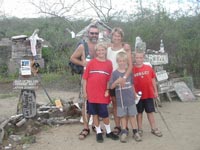 we
encountered nowhere else! While waiting for the officials to get
their act together, we walked out of town to checkout the Darwin
Interpretation Center. This is an
elegantly designed facility, architecturally-speaking, with a bunch
of fancy graphics, explaining the history of the islands yet again,
this time with an emphasis on the human impact. Personally, I found
the graphics very hard to read, the displays a bit dull, and there
was little info there we hadn't already picked up from the guidebook.
Behind the center, however, was a network of marked hiking paths
that we probably would have enjoyed had we figured them out earlier. we
encountered nowhere else! While waiting for the officials to get
their act together, we walked out of town to checkout the Darwin
Interpretation Center. This is an
elegantly designed facility, architecturally-speaking, with a bunch
of fancy graphics, explaining the history of the islands yet again,
this time with an emphasis on the human impact. Personally, I found
the graphics very hard to read, the displays a bit dull, and there
was little info there we hadn't already picked up from the guidebook.
Behind the center, however, was a network of marked hiking paths
that we probably would have enjoyed had we figured them out earlier.
Post
Office Bay, Floreana
Latitude: 01-14.070S; Longitude: 090-27.059W
Nine
days after our arrival in Wreck Bay (where does the time go?) we
weighed anchor and sailed SW to Floreana, the southernmost island
of the archipelago. Floreana is famous for Post Office Bay, where
in 1793 a roofed barrel was set up for whalers and other seafarers
to leave mail. The theo ry
was that passing ships would collect the letters and carry them
to civilization. Despite what you might think, the Post Office Barrel
endures, much decorated by more light-hearted visitors, and frankly
mail service in and out may beat the national carrier given the
number of tour boats that make it a quickie stop each day. The idea
is that visitors not only leave mail, but collect mail for their
home "port." We picked up some postcards addressed to
the mid-west, and we are thinking to add a sticker letting the recipients
know that their card left the island by traditional means...aka
sailboat. We left a bunch of letters for our mutual families' youngest
generation; they should be popular as we actually put US postage
on them! Anyway, we are grateful for the persistence of tradition
because Post Office Bay is the only "natural" anchorage
cruisers are officially allowed to anchor in! While the tour boats
came and went all day, visiting the barrel and a solitary lava tube,
we lingered a luxurious three days doing little more than enjoying
the uninhabited setting. On our second day we were joined by Capaz,
a 48' ketch from Boulder, Co. Capaz is home to a family of five,
including Brian (11), Scott (8) and Chris (7), with whom we have
since had great adventures. They had their own great adventure in
Post Office Bay when Dad and the boys went spear-fishing for supper,
only to have their catch taken off the spear by an 7' shark! ry
was that passing ships would collect the letters and carry them
to civilization. Despite what you might think, the Post Office Barrel
endures, much decorated by more light-hearted visitors, and frankly
mail service in and out may beat the national carrier given the
number of tour boats that make it a quickie stop each day. The idea
is that visitors not only leave mail, but collect mail for their
home "port." We picked up some postcards addressed to
the mid-west, and we are thinking to add a sticker letting the recipients
know that their card left the island by traditional means...aka
sailboat. We left a bunch of letters for our mutual families' youngest
generation; they should be popular as we actually put US postage
on them! Anyway, we are grateful for the persistence of tradition
because Post Office Bay is the only "natural" anchorage
cruisers are officially allowed to anchor in! While the tour boats
came and went all day, visiting the barrel and a solitary lava tube,
we lingered a luxurious three days doing little more than enjoying
the uninhabited setting. On our second day we were joined by Capaz,
a 48' ketch from Boulder, Co. Capaz is home to a family of five,
including Brian (11), Scott (8) and Chris (7), with whom we have
since had great adventures. They had their own great adventure in
Post Office Bay when Dad and the boys went spear-fishing for supper,
only to have their catch taken off the spear by an 7' shark!
Villamil,
Isabela
Latitude: 00-57.93S; Longitude: 090-57.76W
The
fourth and final anchorage available to cruisers is off the town
of Villamil on the SW corner of Isabela, the largest island in the
Galapagos. We sailed west on a windless day in tandem with Capaz
(actually we LEFT in tandem with Capaz and arrived about an hour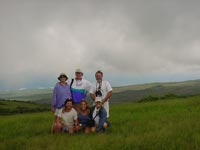 after them! Can we say "Big engine!") The anchorage was
tucked behind what looks almost like a man-made seawall, which is
in reality a scattering of barrier islets comprised of wildly eroded
lava rock. By repute it is the most popular Galapagos anchorge with
cruisers, but that is certainly not based on it's comfort level.
It's a bouncy anchorage, which was tightly packed with cruising
boats as we rounded into it with our high temperature alarm sounding!
Talk about timing. We scooted to the front and dropped our hook
rather less deliberately than usual, and got the engine shut down
quickly. The culprit? Depleted coolant thanks to a leaking fresh
water pump. Always grand to end six hours of motoring with a shot
of adrenalin! We stayed in the Villamil anchorage for six nights
dividing our time between pump repair (Don likes to approach these
projects slowly and thoughtfully when he has the time!), reading,
excursions ashore and fishing expeditions with the Capaz clan. The
town was quite different. Despite a relatively small population
and also relatively little tourism, with the luxury of space, the
stree
after them! Can we say "Big engine!") The anchorage was
tucked behind what looks almost like a man-made seawall, which is
in reality a scattering of barrier islets comprised of wildly eroded
lava rock. By repute it is the most popular Galapagos anchorge with
cruisers, but that is certainly not based on it's comfort level.
It's a bouncy anchorage, which was tightly packed with cruising
boats as we rounded into it with our high temperature alarm sounding!
Talk about timing. We scooted to the front and dropped our hook
rather less deliberately than usual, and got the engine shut down
quickly. The culprit? Depleted coolant thanks to a leaking fresh
water pump. Always grand to end six hours of motoring with a shot
of adrenalin! We stayed in the Villamil anchorage for six nights
dividing our time between pump repair (Don likes to approach these
projects slowly and thoughtfully when he has the time!), reading,
excursions ashore and fishing expeditions with the Capaz clan. The
town was quite different. Despite a relatively small population
and also relatively little tourism, with the luxury of space, the
stree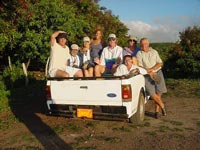 t
plan is wide, although the streets themselves are sand, and the
houses well separated. There are more stores than you would imagine,
and several great panaderias, all of which we checked out in the
search for useful foodstuffs! Restaurants made little money from
us, however, since getting in to and out from shore was a bit dicey
with the tidal change, which exposed a huge maze of rock to negotiate.
Not a good nighttime thing! Our big adventure, a horseback trip
up the Sierra Negra Volcano (1370m), took place one day late. I
say that because the day before our excursion was beautiful and
sunny, while the day we all went -- the 2Cs, the 5 Capazies and
Harold and Lise from the Danish boat Mega Dream -- was cloudy, and,
you got it, drizzly and cold on the mountain. I'm sure the vistas
across the caldera, at 10k wide one of the largest on earth, are
spectacular. We couldn't see ten feet! On the northern side, we
dismounted and hiked down through lava debris to Volcan Chino, which
erupted in 1979 for a lunch stop with a view said to overlook Elizabeth
Bay and Fernadina. We saw a glint of water in a momentary cloud
break. HOWEVER, all that said, we had a ball. How can you not with
three boys and bunch of adults giggling and jiggling through the
mist on a herd of horses being driven forward by the clucks of their
owner driving them from the back of the pack!?! It really was a
most amazing operation. The horses are among 25 belonging to Modesto
and his family, but only one person attends if the group is under
eleven! After we climbed from the open pickup truck, Modesto disappeared
into the mists with no explanation for some 45 minutes, leaving
the gringos to snack and speculate and to try and stay dry and warm.
When the chips and cookies were nearly gone, Modesto reappeared
with ten horses (not counting the two 5 month-old foals taging along!)
strung out head to tail. The "tack" was comprise t
plan is wide, although the streets themselves are sand, and the
houses well separated. There are more stores than you would imagine,
and several great panaderias, all of which we checked out in the
search for useful foodstuffs! Restaurants made little money from
us, however, since getting in to and out from shore was a bit dicey
with the tidal change, which exposed a huge maze of rock to negotiate.
Not a good nighttime thing! Our big adventure, a horseback trip
up the Sierra Negra Volcano (1370m), took place one day late. I
say that because the day before our excursion was beautiful and
sunny, while the day we all went -- the 2Cs, the 5 Capazies and
Harold and Lise from the Danish boat Mega Dream -- was cloudy, and,
you got it, drizzly and cold on the mountain. I'm sure the vistas
across the caldera, at 10k wide one of the largest on earth, are
spectacular. We couldn't see ten feet! On the northern side, we
dismounted and hiked down through lava debris to Volcan Chino, which
erupted in 1979 for a lunch stop with a view said to overlook Elizabeth
Bay and Fernadina. We saw a glint of water in a momentary cloud
break. HOWEVER, all that said, we had a ball. How can you not with
three boys and bunch of adults giggling and jiggling through the
mist on a herd of horses being driven forward by the clucks of their
owner driving them from the back of the pack!?! It really was a
most amazing operation. The horses are among 25 belonging to Modesto
and his family, but only one person attends if the group is under
eleven! After we climbed from the open pickup truck, Modesto disappeared
into the mists with no explanation for some 45 minutes, leaving
the gringos to snack and speculate and to try and stay dry and warm.
When the chips and cookies were nearly gone, Modesto reappeared
with ten horses (not counting the two 5 month-old foals taging along!)
strung out head to tail. The "tack" was comprise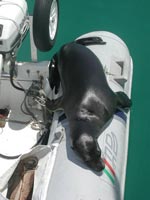 d
of homemade pseudo western saddles made from rebar covered in padding
and plastic. Cinches, stirrup straps and bridles that were no more
than loops around the lower jaw with reins knotted back were made
from polyprop rope! There wasn't a horse in the group that looked
big enough for either of the two captains! They may have been small,
but the horses proved to be a hardy, wel-trained, willing bunch
and they carried us all, despite hugely varying levels of experience,
without mishap several hours up the wet muddy trail and back again.
The head to tail thing evaporated the moment we mounted, and from
then on it was a free-for-all herd, with bodies bumping and shoving
as whoever got closest to Modesto at the back suddenly quickened
his pace through the pack! Don got given the only horse with an
attitude problem. Don named him Trigger. On the way back down the
mountain in the truck, Modesto took us by the Isabela tortoise-breeding
center where we could see bo d
of homemade pseudo western saddles made from rebar covered in padding
and plastic. Cinches, stirrup straps and bridles that were no more
than loops around the lower jaw with reins knotted back were made
from polyprop rope! There wasn't a horse in the group that looked
big enough for either of the two captains! They may have been small,
but the horses proved to be a hardy, wel-trained, willing bunch
and they carried us all, despite hugely varying levels of experience,
without mishap several hours up the wet muddy trail and back again.
The head to tail thing evaporated the moment we mounted, and from
then on it was a free-for-all herd, with bodies bumping and shoving
as whoever got closest to Modesto at the back suddenly quickened
his pace through the pack! Don got given the only horse with an
attitude problem. Don named him Trigger. On the way back down the
mountain in the truck, Modesto took us by the Isabela tortoise-breeding
center where we could see bo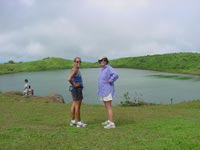 th
dome-back and saddle-back giant tortoises of many sizes. We also
swung by a salt water lagoon in order to add flamingos to our Galapagos
bird list. Speaking of which, we were all thrilled to finally see
several male vermillion flycatchers, from whose bright red coloring
the species gets its name! The other especially neat excursion in
Villamil is to the barrier islets themselves. Here we found a lunar
landscape of angular black lava towers inhabited by lava lizards
and, along the shore, thousands of marine iguanas. Marine iguanas
only exist in the Galapagos. They are distinguished from their land
cousins by their color (black with white specks to match the lava
rock), by being uglier (not easy), and by having adapted to a totally
vegetarian diet of marine (underwater) algae, a perfect example
of Darwinian theory. Also on one of the islets is the "Shark
Pool". This is an apparently natural corridor of water through
the island that attracts numbers of white-tipped sharks. On any
day you can easily look down on a dozen or so millng around. On
our second visit, we had a sea lion pup doing aquabatics through
and overtop the sharks, each oblivious to the other! The sea lions
were definitely a major element of the anchorage at Villamil. They
were always around the boats and throu th
dome-back and saddle-back giant tortoises of many sizes. We also
swung by a salt water lagoon in order to add flamingos to our Galapagos
bird list. Speaking of which, we were all thrilled to finally see
several male vermillion flycatchers, from whose bright red coloring
the species gets its name! The other especially neat excursion in
Villamil is to the barrier islets themselves. Here we found a lunar
landscape of angular black lava towers inhabited by lava lizards
and, along the shore, thousands of marine iguanas. Marine iguanas
only exist in the Galapagos. They are distinguished from their land
cousins by their color (black with white specks to match the lava
rock), by being uglier (not easy), and by having adapted to a totally
vegetarian diet of marine (underwater) algae, a perfect example
of Darwinian theory. Also on one of the islets is the "Shark
Pool". This is an apparently natural corridor of water through
the island that attracts numbers of white-tipped sharks. On any
day you can easily look down on a dozen or so millng around. On
our second visit, we had a sea lion pup doing aquabatics through
and overtop the sharks, each oblivious to the other! The sea lions
were definitely a major element of the anchorage at Villamil. They
were always around the boats and throu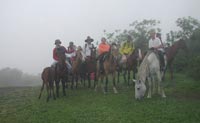 gh
the night you could hear them fishing under the boat, their exhalations
bubbling up around the hull til you'd have sworm there was a scuba
diver down there! We had a pup make itself quite at home in our
dinghy, taking the sun stretched out on the pontoon. But the absolute
best sea lion story is Don's. As he says it will probably be his
fishing story of the year. "I have been fishing with the Capaz
boys (including their Dad) in the dinghy just about every night.
The boys have so much energy and enthusiasm for everything, it has
really been fun to be with them (although I am also glad that I
am not their father, because there is absolutely no way I could
have enough energy to keep up the pace 24 hours a day like Dad does!)
Anyway, the boys liked to go in our dinghy because it is bigger.
We take two rods for the five of us and there are lots of directions
on what we should be doing and how we should be doing it. Chris,
the youngest is the most ardent fisherman. Every night we catch
something. We don't always get it into the boat... but we hook them
and we get all the excitement of the "big catch" with
each hit. "On the last night I went with them the oldest boy,
Brian, was in charge of my rod (I drive, so I don't have rod duty),
and he got the first strike. After about 2 minutes, the progress
of getting the fish to the boat was not good, and he tired. Dad
(his) took over, I turned the dinghy towards the fish, and we started
to chase it. In about 2 more minutes the fish surfaced way, way,
way out from the dinghy...it's a good-size fish. We could tell from
its tail which was sticking out of the mouth of this much bigger
sea lion (not a good day for the fish!). For the next 15 minutes
we chased this stupid sea lion that has our fish. At one point,
this took us right by an official Navy vessel. Mind you, we are
not entirely sure it is legal for us to be fishing in Galapagos
waters, however at the sight of us they just pointe gh
the night you could hear them fishing under the boat, their exhalations
bubbling up around the hull til you'd have sworm there was a scuba
diver down there! We had a pup make itself quite at home in our
dinghy, taking the sun stretched out on the pontoon. But the absolute
best sea lion story is Don's. As he says it will probably be his
fishing story of the year. "I have been fishing with the Capaz
boys (including their Dad) in the dinghy just about every night.
The boys have so much energy and enthusiasm for everything, it has
really been fun to be with them (although I am also glad that I
am not their father, because there is absolutely no way I could
have enough energy to keep up the pace 24 hours a day like Dad does!)
Anyway, the boys liked to go in our dinghy because it is bigger.
We take two rods for the five of us and there are lots of directions
on what we should be doing and how we should be doing it. Chris,
the youngest is the most ardent fisherman. Every night we catch
something. We don't always get it into the boat... but we hook them
and we get all the excitement of the "big catch" with
each hit. "On the last night I went with them the oldest boy,
Brian, was in charge of my rod (I drive, so I don't have rod duty),
and he got the first strike. After about 2 minutes, the progress
of getting the fish to the boat was not good, and he tired. Dad
(his) took over, I turned the dinghy towards the fish, and we started
to chase it. In about 2 more minutes the fish surfaced way, way,
way out from the dinghy...it's a good-size fish. We could tell from
its tail which was sticking out of the mouth of this much bigger
sea lion (not a good day for the fish!). For the next 15 minutes
we chased this stupid sea lion that has our fish. At one point,
this took us right by an official Navy vessel. Mind you, we are
not entirely sure it is legal for us to be fishing in Galapagos
waters, however at the sight of us they just pointe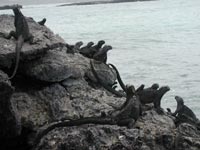 d
and laughed. Finally, after going forward, backwards and sideways,
the sea lion got back to his reef shelter and the line got cut on
the sharp lava rocks. Once the line was free the thief took off
to the open water on the surface with the fish hanging out of his
mouth, us still chasing him in the dinghy and all 3 boys screaming
at him to "drop our fish!!!!". It was pretty funny and
I'm sure this will be the fish story of the year for me. Oh, yeah....did
I mention that was our last lure!!!" d
and laughed. Finally, after going forward, backwards and sideways,
the sea lion got back to his reef shelter and the line got cut on
the sharp lava rocks. Once the line was free the thief took off
to the open water on the surface with the fish hanging out of his
mouth, us still chasing him in the dinghy and all 3 boys screaming
at him to "drop our fish!!!!". It was pretty funny and
I'm sure this will be the fish story of the year for me. Oh, yeah....did
I mention that was our last lure!!!"
Academy Bay,
Santa Cruz
Latitude: 00-44.90S; Longitude: 090-18.50W
We
are now back rocking and bobbing in Academy Bay. The town has had
a complete personality makeover now that the airport here has reopened.
All the shops are open, the shelves are well stocked, and tour agents
are out hustling business from the throngs of tourists on the streets!
But of course!!!! We are here to get ready for our passage back
to Western Panama. Ca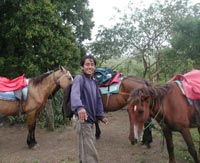 paz
and Lite N Up are here, too, and they also are getting ready to
leave, only westward to the Marquesas. It is going to be hard to
part ways, although we will find more old friends as well as new
ones back in Central America. We have had a good stay. It is probably
not the way to DO the Galapagos. To DO the Galapagos you need a
two-week trip on a good tour boat with an English-speaking naturalist
that can take you to all the far-flung corners of the archipelago
where the most exotic creatures like the flightless cormorant, waved
albatross and Galapagos penguin reside, where outrageous volcanic
formations stand isolated, and where are, of course, the really
special world-class dive sites where whale sharks dance with the
manta rays. paz
and Lite N Up are here, too, and they also are getting ready to
leave, only westward to the Marquesas. It is going to be hard to
part ways, although we will find more old friends as well as new
ones back in Central America. We have had a good stay. It is probably
not the way to DO the Galapagos. To DO the Galapagos you need a
two-week trip on a good tour boat with an English-speaking naturalist
that can take you to all the far-flung corners of the archipelago
where the most exotic creatures like the flightless cormorant, waved
albatross and Galapagos penguin reside, where outrageous volcanic
formations stand isolated, and where are, of course, the really
special world-class dive sites where whale sharks dance with the
manta rays.
The 2C Galapagos
Wildlife Check List
Geckos
Lava Lizards
Marine Iguanas
Land Iguanas
Marine Turtles: green & black
Galapagao Giant Tortoises: saddleback & dome types
Lava Gull
Swallowtail Gull
Audubon Shearwater
Galapagos Storm Petrel
Brown Noddi
Frigatebirds: Great & Magnificent
Tropicbirds
Brown Pelicans
Boobies: Masked, Blue-footed, Red-footed Boobies
Great Blue Heron
Lava Heron
Yellow-Crowned Night Heron
Egrets
Oystercatchers
Flamingoes
Bahama Pintail Ducks
Sanderlings
Purple Gallinule
Galapagos Mockingbirds
Vermillion Flycathcers, male & female
Large-billed flycatchers
Yellow Warblers
Smooth-billed Ani
Galapagos Rail
Galapagos Hawk
Assorted finches (only Darwin could tell?)
Sea Lions
Bottlenose dolphins
Scalloped Hammerhead Shark
White-tipped Sharks
Galapagos Sharks
Manta Rays
Cow Nose Rays
Eagle Rays
Spiny lobster\Slipper lobster
Octopus
Fish too numerous to identify
Ditto for invertebrates
|